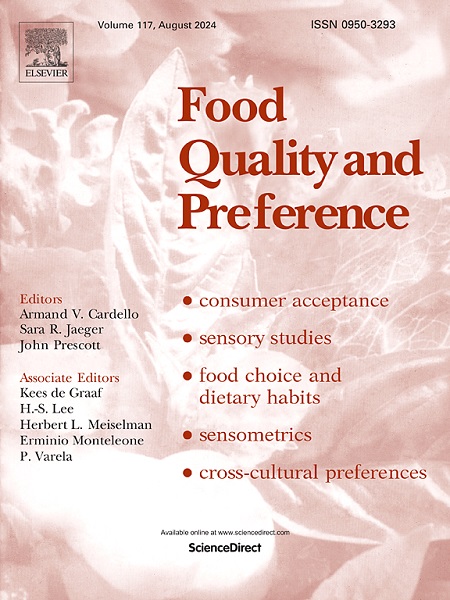Clustering method and stimulus presentation order shift sweet liking phenotype distributions
IF 4.9
1区 农林科学
Q1 FOOD SCIENCE & TECHNOLOGY
引用次数: 0
Abstract
Sweet liking is a phenotype with an intuitive connection to nutrition and health, but phenotyping methods and association with health outcomes reported in the literature are highly variable. Recently, a “Rapid Method” of phenotyping based on 1 M sucrose solution liking was proposed, but validation of this method in new subject groups is needed. This study compared sweet liking phenotyping methods against 3 reliability criteria. Participants (n = 92, aged 18–55 years) rated their liking of both a 5-concentration series of sucrose solutions and a stand-alone 1 M sucrose solution. Participants were classified as sweet likers, sweet dislikers, or inverted U-shape using 7 hierarchical clustering analysis (HCA) linkage methods, the Rapid Method, and a method based on the slope of the liking-sucrose concentration function (“Slope Method”). The proportion of sweet likers, defined as members of the cluster with the highest mean 1 M sucrose liking, varied widely from 1 % to 48 % depending on HCA method; in comparison, the Rapid and Slope methods classified 39 % and 51 % of participants as sweet likers, respectively. Liking for sucrose solutions decreased systematically across presentations (p = 0.00046); 63 % of participants who rated the 1 M solution first met the Rapid Method cut-off for sweet likers compared to 39 % of participants who rated it last. The Slope Method achieved the highest intragroup correlations while reproducing the commonly recognized phenotypes, but performance of the Rapid Method is strong enough to warrant its continued use when convenience is of paramount importance. Replication in larger cohorts is needed to validate these results.
聚类方法和刺激呈现顺序改变喜甜表型分布
喜欢甜食是一种与营养和健康有直观联系的表现型,但文献中报道的表现型方法和与健康结果的关联是高度可变的。最近,一种基于1 M蔗糖溶液喜好的“快速方法”被提出,但该方法需要在新的受试者群体中进行验证。本研究比较了三种可靠性标准下的甜味偏好表型方法。参与者(n = 92,年龄在18-55岁之间)对他们对5浓度系列蔗糖溶液和单独的1 M蔗糖溶液的喜爱程度进行了评分。通过7种层次聚类分析(HCA)联系方法、快速方法和基于喜好-蔗糖浓度函数斜率的方法(“斜率法”),将参与者分为喜甜者、不喜甜者或倒u型。甜味偏好者的比例,定义为具有最高平均1 M蔗糖偏好的集群成员,根据HCA方法的不同,从1%到48%不等;相比之下,快速法和斜坡法分别将39%和51%的参与者归类为甜食爱好者。对蔗糖溶液的喜爱度在演示过程中系统性地下降(p = 0.00046);首先对1m溶液打分的参与者中有63%的人达到了快速方法对甜食爱好者的截止值,而最后对1m溶液打分的参与者中只有39%的人达到了截止值。斜率法在再现常见表型时获得了最高的组内相关性,但快速法的性能足够强大,可以保证在最重要的情况下继续使用。需要在更大的队列中进行复制来验证这些结果。
本文章由计算机程序翻译,如有差异,请以英文原文为准。
求助全文
约1分钟内获得全文
求助全文
来源期刊

Food Quality and Preference
工程技术-食品科技
CiteScore
10.40
自引率
15.10%
发文量
263
审稿时长
38 days
期刊介绍:
Food Quality and Preference is a journal devoted to sensory, consumer and behavioural research in food and non-food products. It publishes original research, critical reviews, and short communications in sensory and consumer science, and sensometrics. In addition, the journal publishes special invited issues on important timely topics and from relevant conferences. These are aimed at bridging the gap between research and application, bringing together authors and readers in consumer and market research, sensory science, sensometrics and sensory evaluation, nutrition and food choice, as well as food research, product development and sensory quality assurance. Submissions to Food Quality and Preference are limited to papers that include some form of human measurement; papers that are limited to physical/chemical measures or the routine application of sensory, consumer or econometric analysis will not be considered unless they specifically make a novel scientific contribution in line with the journal''s coverage as outlined below.
 求助内容:
求助内容: 应助结果提醒方式:
应助结果提醒方式:


